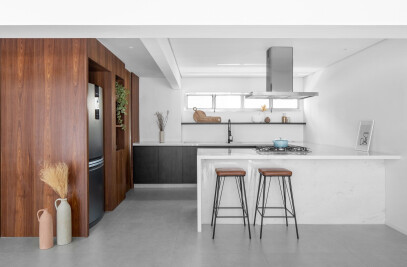The original plan of this apartment had segmented and underutilized rooms, due to a large area dedicated to service. The main goal was to bring openness and optimize the spaces so that the small apartment became more functional and practical for day-to-day activities.

The old plan was redesigned with every corner in mind. The social area became more integrated and one of the rooms became a suite. The millwork was well planned so that they could guarantee generous storage spaces while also indicating the sectorization of spaces.
The result was a compact apartment with light tones and finishes that are easy to maintain.

What was the brief?
Making the room wider, brighter and more ventilated. Integrating spaces to make the social area more pleasant. Segregated environments were not a necessity for the client and the amount of area devoted to service was exaggerated for the profile of the new residents.

What were the key challenges?
The challenge was to make the apartment more functional, with spaces designed to meet the needs of the residents and facilitate daily life. To bring the feeling of spaciousness and provide enough room for storage, since the customer was moving to a smaller home and would need to organize and store all their belongings.

What were the solutions?
The first step was to redesign the plan, eliminating some walls and opening up the rooms. The kitchen was integrated into the living room and the delimitation of these environments occurs mainly by the difference in the floor finish. The tile extends throughout the entire service area, and the kitchen and laundry room are organized into a single counter. The wall that encloses the refrigerators hides the clothesline and the pantry shelf. In addition, another important point in this transformation was the change in the access to the service bathroom, allowing for the creation of an ensuite bedroom.

The second step was to design the millwork. Any storage space was important and would help in the clients’ organization, in addition to being important to the sertorization of spaces. A white panel works as background for the television in the living room, and when going into the kitchen it becomes a bookcase that blends with the kitchen cabinets.

Finally, the choice of materials was guided by easy maintenance and light tones. The use of mauve oak in the millwork combined with white and cream tones on the walls made the apartment lighter and more spacious. (Playing with color inversion in millwork also helps in defining spaces.)

The tile came in as a color highlight. We decided to use burnt shade of pink on the entire kitchen and laundry floor and to use the same color in some details on the white tile chosen for the wall. In the bathrooms, we used burnt cement tiles on the floor and the tiles on the walls brought texture to the environment that is predominantly white.
























































